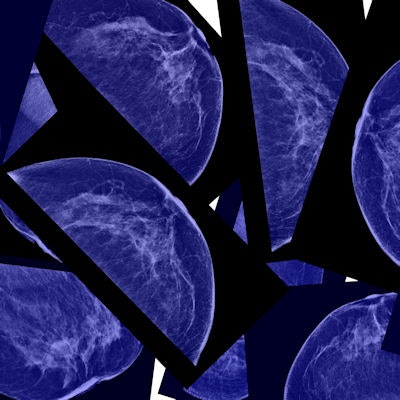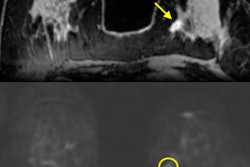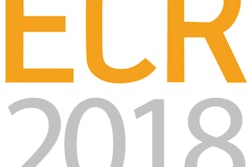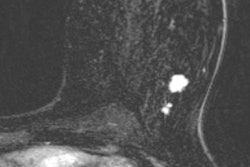
German researchers have developed a novel breast MRI technique that greatly reduces false-positive findings and increases the detection of breast cancer -- without the need for a gadolinium-based contrast agent, according to a study published online February 20 in Radiology.
The approach features a form of diffusion-weighted MRI (DWI-MRI) known as diffusion kurtosis imaging, which analyzes the distribution of water to evaluate breast tissue structures at a microscopic level. A software algorithm based on a kurtosis radiomics model then extracts imaging data to accurately characterize the lesions (Radiology, February 20, 2018).
"[The] model ... reduces false-positive results by 70% in lesions classified as BI-RADS 4 or 5 at screening mammography while retaining sensitivity greater than 98%," wrote lead author Dr. Sebastian Bickelhaupt, from the German Cancer Research Center in Heidelberg, and colleagues. "Since malignant lesions disrupt the tissue structures at this level, diffusion kurtosis might serve as a relevant marker of changes."
Contrast challenges
Previous studies have shown that with the addition of a contrast agent with ultrasound or mammography, positive predictive values can increase from 13%-17% to 69%-78% for women with more severe cases of suspected cancer, such as BI-RADS 4.
When a follow-up MRI scan is needed to better determine a diagnosis, a gadolinium-based contrast agent (GBCA) is the standard course of action. GBCAs, however, have become somewhat controversial, as studies have shown that minute traces of the element can linger in the body's tissues long after administration.
To help alleviate any concerns about gadolinium and to better manage patients who may have contraindications for contrast, the researchers developed a software algorithm based, in part, on radiomics that can gather a massive amount of data from images. They tested the algorithm in a multicenter study that analyzed patient information from DWI breast MRI exams performed between 2014 and 2016.
All of the women were referred for follow-up MRI scans and possible biopsy after a suspicious finding for cancer (BI-RADS 4 or 5) on mammography. DWI breast scans were conducted on MRI devices at two different imaging facilities. The patients underwent biopsy after the DWI scans.
One institution used a 1.5-tesla scanner (Magnetom Aera, Siemens Healthineers) and a two-channel breast coil to image 95 patients (mean age, 58.6 ± 6.6 years). In this group, 61 women had malignancies and 34 had benign lesions. This set of patients served as the training set for the kurtosis-based radiomics model. The second facility used a 1.5-tesla scanner (Ingenia, Philips Healthcare) and a two-channel breast coil to image 127 patients (mean age, 58.2 ± 6.8 years). Among these women, 61 had malignancies and 66 had benign lesions, which were used to test the model.
Enhanced detection
Among all 222 patients, histopathology results confirmed malignant lesions in 122 women (55%); invasive ductal carcinoma was the most common finding, in 90 patients (74%). Benign lesions were found in the remaining 100 women (45%); fibrosis (21 patients, 21%) and fibroadenoma (20 patients, 20%) were the most common abnormalities.
In the test group of 127 patients, the kurtosis-based radiomics model reduced the number of false-positive results from 66 to 20, achieving specificity of 70% (46 of 66). The model also detected 60 of 61 malignant lesions, for sensitivity of 98%. The model missed one true-positive result.
Breaking the results down further, the model reached sensitivity of 100% in women with BI-RADS 4A and 4B breast cancer. It also reduced false positives from 50 to 13 for the BI-RADS 4A patients and from 15 to nine for those with BI-RADS 4B cancer.
| Diagnostic performance of kurtosis radiomics model to detect lesions | ||
| Sensitivity | Specificity | |
| All patients | 98% (60/61) | 70% (46/66) |
| BI-RADS 4A | 100% (9/9) | 74% (37/50) |
| BI-RADS 4B | 100% (29/29) | 60% (9/15) |
| BI-RADS 5 | 96% (22/23) | 0% (0/1) |
"A radiomics breast cancer model based on DWI with adapted kurtosis fitting allowed for improved differentiation between malignant and benign breast lesions in both training and independent test datasets acquired by using MR imaging machines from different vendors at different institutions," Bickelhaupt and colleagues wrote.
If the findings are validated further, the researchers suggest that the kurtosis radiomics model could have additional advantages beyond reducing unnecessary biopsies in women with BI-RADS 4 lesions. They did stress, however, that their approach is not designed to replace current contrast-enhanced breast MRI protocols in general, but rather to expand diagnostic options to answer specific clinical questions.


















